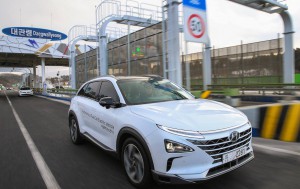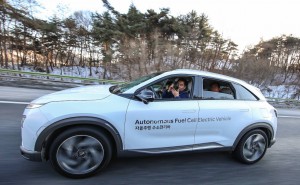As thousands of athletes descend on Pyeongchang, South Korea for the Winter Olympics this week, Hyundai engaged in its own special event as three of is fuel-cell powered Nexo concept crossovers headed to the Olympic city.
Three fuel cell vehicles making the nearly 120-mile trek from Seoul to Pyeongchang isn’t all that impressive except they were using Level 4 autonomous technology to make the trip on their own: a first for FCVs.
The vehicles used for the demonstration are “futuristic vehicles” that closely represent Hyundai’s three visions for future mobility: connected mobility; freedom in mobility; and clean mobility, the automaker noted.
The demonstration started in Seoul on Feb. 2 with the ‘CRUISE’ and ‘SET’ buttons being pressed on the autonomous-driving steering wheel of each vehicle, which switched to self-driving mode and began the 118-mile trip to Pyeongchang.
(Hyundai Nexo will deliver 370 miles on a tank. Click Herefor the story.)
According to Hyundai, the three Nexos and two Genesis G80s jumped on a highway getting into the natural flow of traffic, executed lane changes and overtaking maneuvers, and navigated toll gates using Hi-pass, South-Korea’s wireless expressway payment system.
They managed all of these moves at speeds at fast as 70 mph. Hyundai conducted a significant number of highway test drives amounting to hundreds of thousands of kilometers travelled, which enabled them to accumulate a vast amount of data that helped enhance the performance of its self-driving vehicles.
“Hyundai’s philosophy for developing autonomous driving technology is to provide the highest level of safety combined with a high standard of convenience that our customers expect,” said Jinwoo Lee, head of the Intelligent Safety Technology Center at Hyundai Motor Group.
(Click Here for more about the 2019 Hyundai Veloster heating up the hot hatch market.)
Hyundai says that FCVs are the best autonomous cars and trucks because the autonomous driving processes a high volume of data, which requires a lot of power. The Nexo fuel cell electric SUV can drive more than 600 km on a single charge, which takes approximately five minutes.
The model boasts world-class system efficiency of 60%, durability equivalent to internal combustion engine-driven vehicles and a load space of 839 liters. In all, the Nexo can travel 370 miles on a charge, according to Hyundai.
This was not the first run for the Nexo, the company drove the Nexo from Los Angeles to Las Vegas to determine if the 360-mile range was accurate – it was – and it noted it tackle 0 to 60 in 9.9 seconds. In South Korean, the trial vehicles used a combination of radar, lidar and cameras to monitor their surroundings, and some of these systems are already used in production Hyundai vehicles.
(To see more about Hyundai hitting market with autonomous fuel cell vehicle this year, Click Here.)
The automaker believes the Level 4 vehicles will hit some roads in 2021, but only in targeted cities that have the necessary infrastructure in place to ensure the vehicles can function properly. Fully autonomous vehicles, Level 5, should be ready 2030.


